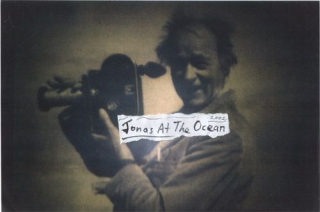Date: 2 November 2003 | Season: London Film Festival 2003 | Tags: London Film Festival
JONAS AT THE OCEAN
Sunday 2 November 2003, at 2pm
London National Film Theatre NFT3
‘Jonas Mekas and his friends of free film, art and music.
A documentarypsychomusicfilm by Peter Sempel’
Peter Sempel, Jonas at the Ocean, Germany, 2002, 93 min
Together with his brother Adolphas, Jonas Mekas left Lithuania during World War II and eventually travelled to America as a ‘displaced person’. After settling in New York, he soon purchased a movie camera and began documenting the lives of Lithuanian immigrants. Within a few years, he was to become a central figure in the movement toward the recognition of film as art. The brothers’ arrival in New York (1949) is the film’s point of departure, and readings from ‘I Had Nowhere to Go’, Jonas’ autobiography of the period, appear throughout. Sempel loosely traces Mekas’ post-war life, as told through his interactions with other members of the arts community. There are visits with Robert Frank, Merce Cunningham and Nam June Paik, and with La Monte Young and Marian Zazeela in their ‘Dream House’. Allen Ginsberg tells the story of Pull My Daisy and the birth of beat cinema, while Phillip Glass speaks of Jonas’ independent sprit and the beginnings of the downtown arts scene in the 60s. Sempel borrows liberally from Mekas’ own films, while offering us glimpses of a life which we are more often used to seeing from his own point of view looking out.
PROGRAMME NOTES
JONAS AT THE OCEAN
Sunday 2 November 2003, at 2pm
London National Film Theatre NFT3
JONAS AT THE OCEAN
Peter Sempel, Germany, 2002, 16mm, colour, sound, 93 min
It’s actually a prolongation of Jonas In The Desert, so Part Two, but with less talking and more music. I think , feel with music you can come nearer to something , someone than with any words (of course there are also interviews, for example with Jonas, Robert Frank, Nam June Paik, Phil Glass…) I’ve been filming Jonas (not shown at all in Part One) and also new scenes as I kept on filming after 1994, actually ’til, 2001. It starts with Jonas at the seashore in Lithuania laughing and filming children and running into the water with his Bolex camera, with ‘Starlight’ by Lou Reed and John Cale (about Warhol films), his hat flies away in the wind … He reads from his book, about the days in Germany … A wonderful scene where he repeats the landing at the Hudson with Algis and his brother Adolphas (filmed in slow motion – Jonas Scholz, the cameraman did a great job!) … Him running through the wide fields of his home country, chasing cows, hugging a white horse, and running to the horizon and back into the camera … Of course also in New York, and Torino, Barcelona, Paris, Berlin, Hamburg, Sao Paulo, Washington, Montauk and … and …
Some highlights: Robert Frank in his studio, talking about the old days, a ‘light show’ with La Monte Young and Marian Zazeela, Nick Cave reads from ‘I Had Nowhere To Go’ (the scene with the peepshow in the 1950s, 42nd Street, it’s beautiful and sad. Nick reads in his little green backyard house in London, dramatically (black + white, 16mm), it’s great.) … More guests: Rudy Burkhardt talking wildly about Maya Deren, Allen Ginsberg, Julius Ziz, Kenneth Anger, Tony Conrad (with a great performance in Buffalo), Stan Brakhage, Vincent Canby, Raimund Abraham, Peter Kubelka, Michael Snow, Fernando Arrabal, Zoe Lund and Harvey Keitel, Wim Wenders (calling Jonas the James Joyce of film art …), Blixa sings a song, Kiki and more … Jonas doing an Artaud performance on the Anthology-stage, at the top of his voice … Really quite crazy he is sometimes, how wonderful! Music: from underground, classical to Lithuanian folksongs. Okay, this could give you a little idea. The whole film is 93min on 16mm. —Peter Sempel
Back to top
